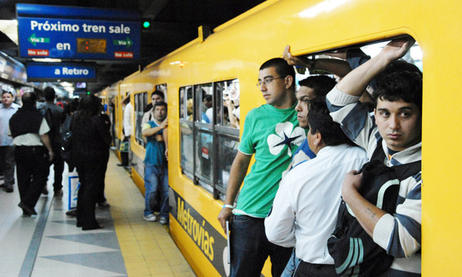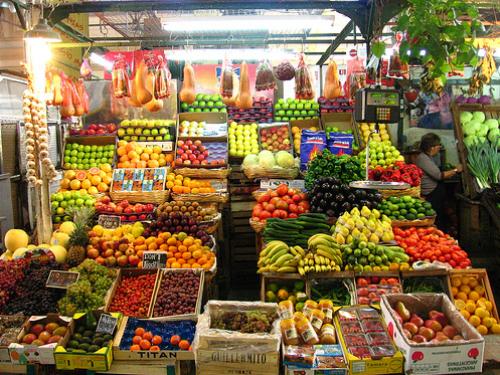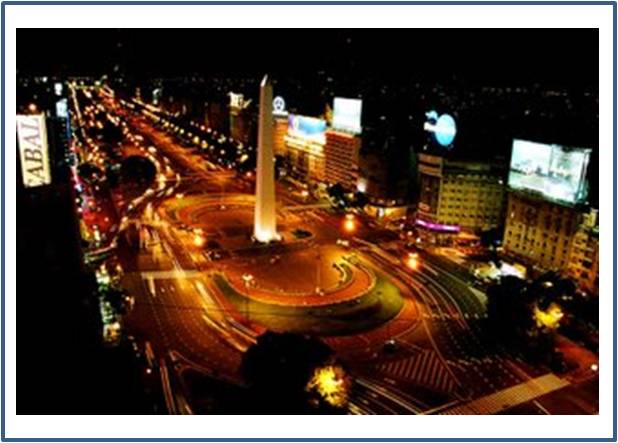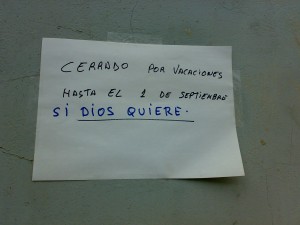When you first arrive to study abroad in Buenos Aires you will most likely marvel at how beautiful, modern, and familiar the city is. With a well-developed infrastructure, a subway, and up to date technology, Buenos Aires is in many ways similar to an urban area of a similar size in the U.S. and Europe. That being said, certain aspects of life while you study abroad Buenos Aires can feel very foreign compared to what you’ve experienced in your home country. In this way Buenos Aires can be deceptively different. One could even argue that this alluring mix of being both exotic and user friendly is what makes Buenos Aires such an excellent choice for a wine course, to study Spanish, or to learn to be DJ abroad.
In our last blog we provided a basic overview of the symptoms and process of “culture shock”, the natural, inevitable, and often turbulent adjustment period every person goes though during their first weeks of study abroad in Argentina. In this installment we’ll get into more detail. We’ll check out three primary cultural differences that can be a little bit “chocante” (shocking), but when viewed from a different perspective have their own positive qualities that will always teach you something new.
SPACE
One of the first things you’ll undoubtedly notice as soon as you set foot in Buenos Aires is the sheer physical impact of the city. You’ll be surrounded by tall buildings on all sides and confront grinding traffic everywhere you turn. As a pedestrian, you will soon discover that you do not have the right-of-way in most traffic situations. In Buenos Aires cars turning both left and right, even in stoplights, do not yield to foot traffic. On the sidewalk you’ll walk along floating in a sea of other people, and on public transportation you’ll have to get used to not having the same personal space “bubble” you might be accustomed to at home as you find yourself pressed again other people at rush hour.
The Upside: Buenos Aires is the 7th largest city in the world, a dynamic metropolis of 3 million people inside the boundary of Capital Federal and 13 million in the province of Buenos Aires. Although hard to adjust to, some of the more claustrophobic elements are small price to pay for such an amazing city so jam-packed with culture, the arts, shopping, restaurants, and people from all over the world.
Although there is in deed a great deal of traffic and noise, but you’ll also find that by hopping on any public transportation or taxi you’ll find yourself on the steps of a museum, at a rooftop party, watching live music, cheering at a sporting event, sitting in the dark of a movie, or gazing at breathtaking architecture in more or less 30 minutes. Public transportation is the lifeblood of the city, ferrying thousands of people across Buenos Aires every minute of everyday. If you’re addicted to your car or a homebody in your country of origin, it can be liberating and magical to see so many people and being constantly confronted with new faces and situations.
deed a great deal of traffic and noise, but you’ll also find that by hopping on any public transportation or taxi you’ll find yourself on the steps of a museum, at a rooftop party, watching live music, cheering at a sporting event, sitting in the dark of a movie, or gazing at breathtaking architecture in more or less 30 minutes. Public transportation is the lifeblood of the city, ferrying thousands of people across Buenos Aires every minute of everyday. If you’re addicted to your car or a homebody in your country of origin, it can be liberating and magical to see so many people and being constantly confronted with new faces and situations.
TIME
Yeah, it sounds kind of metaphysical, but time in all of its forms will be one of the biggest “culture shockers” you’ll have to adapt to. The Rolling Stones (known as the ever popular, “rollingos” in Argentina) once sang “time is on my side” but you’ll undoubtedly feel the opposite during your first months of any study abroad program in Buenos Aires. Here are some key issues:
Punctuality – You may have heard it before, but arriving late in Buenos Aires is very common, and in many
situations tardiness is anticipated, even expected, and rarely requires an apology. Expect 15-40 minute delays on casual meetings with friends, or even academic or medical appointments. When you make social plans with your new argentine amigos, expect that people will show up later that the agreed upon time, and consider doing the same yourself. You’ll never feel like you’re in a rush and you’ll also get to enjoy those crucial extra minutes to put the finishing touches on your outfit before you go out and enjoy Buenos Aires’ famous nightlife.
Late Hours: One of the things newcomers often find most shocking and different about Buenos Aires are the later hours. People eat dinner between 10 pm and 12 am (on the weekends), don’t arrive at bars until after midnight, and enter boliches (clubs) at 2 am at the earliest. When you first arrive in Buenos Aires socializing might seem like an endurance contest in terms of both fatigue and hunger, but within a few weeks you’ll adjust and it will feel natural to eat and go out later. In fact, you’ll probably eventually be shocked that people would even consider eating dinner before sunset or stop dancing before sunrise.
Pace of Life: If you come from a culture or city where convenience, efficiency, and productivity reign supreme, you might find yourself a bit frustrated when you come to take a short course in  Argentina or study Spanish in Buenos Aires. Expect long waits at the post office and supermarket, as well as a generally slower life rhythm where tasks aren’t rushed and may take longer. Waiters don’t regularly check up on clients at restaurants, so you might have to ask several times to order or get your check. Also, in terms of the duration of social events, you might find that social gatherings last longer, and that people tend to linger over dinner or drinks with friends and enjoy sitting and talking for long periods of time.
Argentina or study Spanish in Buenos Aires. Expect long waits at the post office and supermarket, as well as a generally slower life rhythm where tasks aren’t rushed and may take longer. Waiters don’t regularly check up on clients at restaurants, so you might have to ask several times to order or get your check. Also, in terms of the duration of social events, you might find that social gatherings last longer, and that people tend to linger over dinner or drinks with friends and enjoy sitting and talking for long periods of time.
Business Hours– Most normal businesses close at 8pm, and restaurants on weekdays by midnight and 2am at the latest on the weekend. With some exceptions such as McDonald’s and certain cafes concentrated in Palermo Soho where you can grab food at all hours, don’t expect to find a 24 hour diner around every corner. Also, most non-restaurant businesses (with the exception of some malls and shopping districts) have limited Saturday hours and are closed completely on Sunday, so prepare to let go of the idea that weekends are a time to complete your long list of errands and you’ll learn to cherish them as relaxation time. The same applies for the Argentine summer season (January to March), when businesses may close down for weeks at a time.
The Upside: If you are used to getting caught up the daily grind of being busy, “getting things done”, and constantly being on the go, coming to study abroad in Argentina will most likely be an opportunity for a profound life lesson in slowing down, taking time to enjoy, and having more patience. Not having to rush everywhere and be so self conscious about time can be liberating in its own way. The DMV (for Americans) will later seem like a breeze. Of course, it’s frustrating when things take longer or people show up late, but you can harness Argentina’s cultural flexibility with regards to time to your advantage. You’ll get deep into conversations with your new international friends without servers pushing you to free up your restaurant table, and you won’t have to worry about getting in trouble for not arriving on the dot.
The structure of Argentine society forces leisure time to be truly relaxed and social. Sundays are truly Sundays and vacation is truly vacation. This is something we often lose sight of our rushed and neurotic home countries, and perhaps one of the most valuable lessons learned on study abroad in Buenos Aires.
FOOD
Argentina is a land of culinary wonders, something you undoubtedly already know if you’ve for a wine course in Buenos Aires or to study cooking in Argentina. Between the beef, wine, ice-cream, and host of other Spanish, Italian, and Porteño foods you’ll find here, there’s little not to like. That being said, as in any foreign environment, there are some new challenges to adapt in terms of feeding yourself.
Breakfast in Argentina is an understated affair, often taken in the form of toast or cookies, tea, coffee, or mate and perhaps a small yogurt or cereal. If you’re used to bacon, eggs and hashbrowns this might take some getting used to. In the same vein, dinner is late, usually after 10pm whereas lunch takes generally place from 1-2pm, so learning to time your body’s hunger to a new system is a gradual and sometimes stomach-growling process.
Other things you may notice are that, with a few exceptions, many vegetables and other raw produce come unwashed and unpackaged, requiring you to use a little more elbow grease at home. You’ll have to ask  for each item personally, and for travelers not accustomed to the metric system it’s a very useful crash course. Another new challenge might be that fact that apart from big corporate supermarkets (see our comments on long lines above) you’ll probably have to buy the components of any meal at several small local businesses such as a verdulería for fruit and vegetables, a carnicería for meat, and a small kiosko or chino (Asia immigrant owned supermarket) to buy packed goods like cookies, soft drinks, or condiments.
for each item personally, and for travelers not accustomed to the metric system it’s a very useful crash course. Another new challenge might be that fact that apart from big corporate supermarkets (see our comments on long lines above) you’ll probably have to buy the components of any meal at several small local businesses such as a verdulería for fruit and vegetables, a carnicería for meat, and a small kiosko or chino (Asia immigrant owned supermarket) to buy packed goods like cookies, soft drinks, or condiments.
The Upside: This can seem like a hassle, but you’ll burn a few calories ferrying your heavy bags from block to block (making you resemble your svelte fellow porteños) and you´ll get a chance to get to know your neighborhood better. If you’ve been taking an Intensive Spanish Course in Buenos Aires there is no better opportunity to try out some key Spanish phrases during your shopping transactions. You’ll form friendly relationships with the vendors in your neighborhood giving you great exposure to the culture and enriching your study abroad in Argentina experience!
Many foreigners decry the lack of ethnic food in Buenos Aires, but if you look closely and read up you’ll find ample offerings within Buenos Aires’ Chinese, Japanese, Korean, Peruvian, and Middle Eastern communities. Craving a shwarma sandwich, sushi, or just plain old American brunch? Mente Argentina’s young bilingual support staff can help you with some local insider recommendations.
Another common misconception is that vegetarians cannot survive in Argentina, and this is not the case. Although Argentine culture reveres meat and you’ll notice there’s a parilla around every corner, there are plenty of options both inside and outside of traditional Argentine cuisine available for vegetarians in Argentina. Try a tarta de verdura (vegetable quiche) tortilla de papas (Spanish potato omelette) or guiso de lentejas (lentil stew), all commonly served in restaurants. And  don’t forget to sample Buenos Aires´ amazing selection of fresh made pastas, pizzas, and other non-meat Italian fare. You’ll even find a decent quantity of ever more popular vegetarian restaurants including some fantastic vegetarian lunch buffets this Mente staff cannot live without! If you come to visit our student reception office you’ll find well-fed vegetarian and staff members who can give you great tips.
don’t forget to sample Buenos Aires´ amazing selection of fresh made pastas, pizzas, and other non-meat Italian fare. You’ll even find a decent quantity of ever more popular vegetarian restaurants including some fantastic vegetarian lunch buffets this Mente staff cannot live without! If you come to visit our student reception office you’ll find well-fed vegetarian and staff members who can give you great tips.
All in all, although aspects of life in Buenos Aires, Argentina can be new and challenging, no one embarks on an exciting journey to travel or study abroad internationally expecting everything to be the same. Cultural contrasts challenge us; show us a different side of life, and most of all teach us about ourselves.
More to come!
Kayla Burchuk


